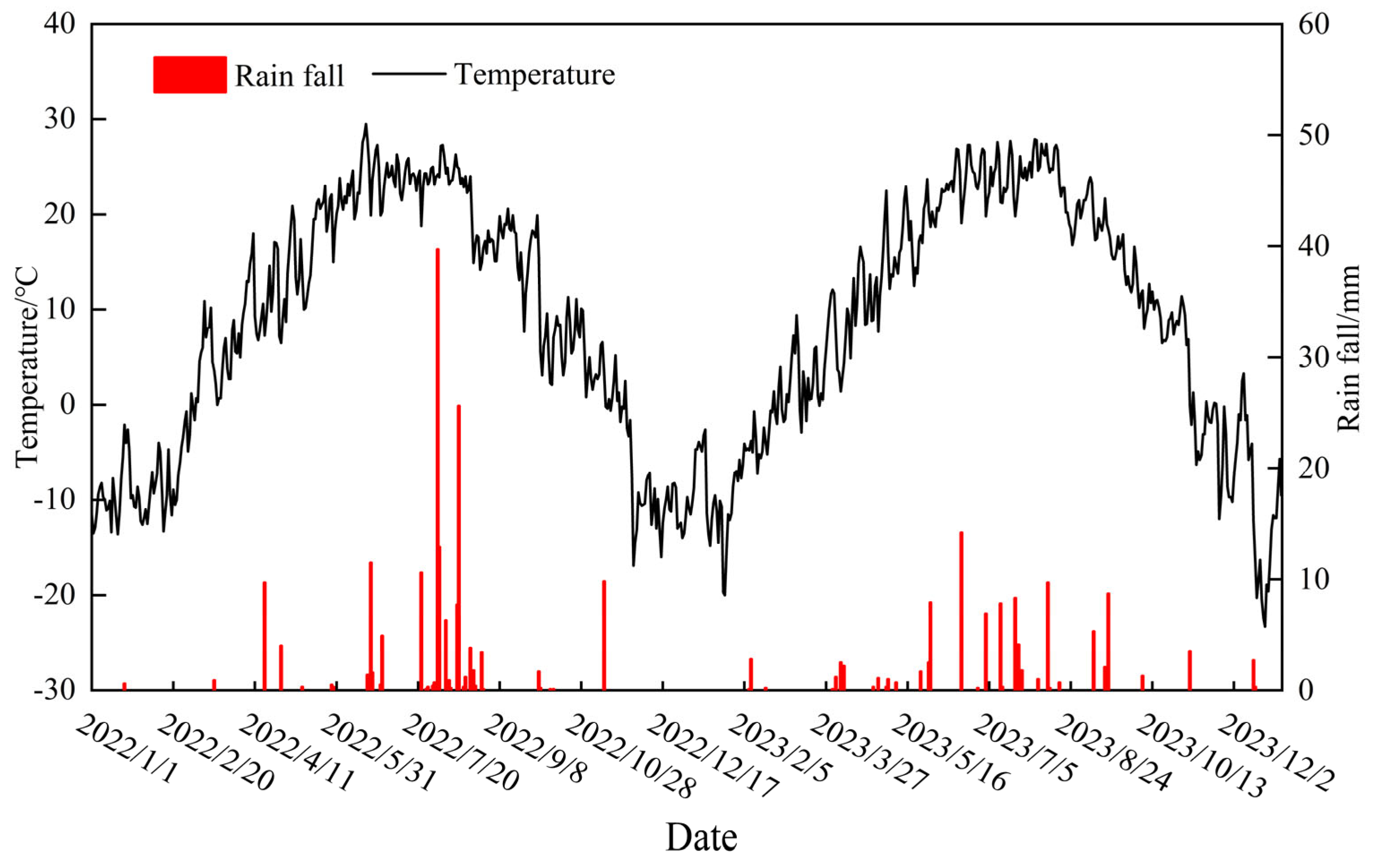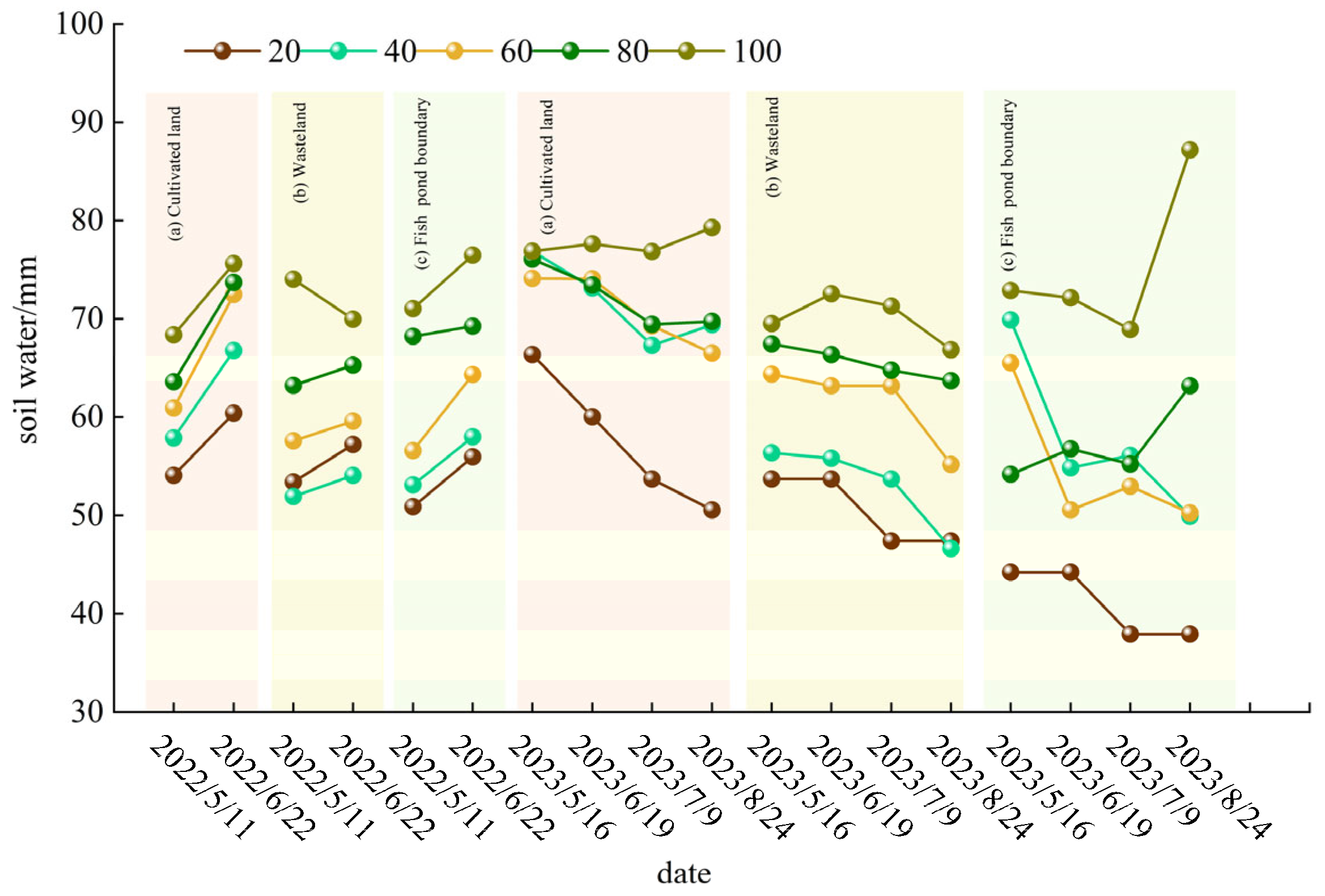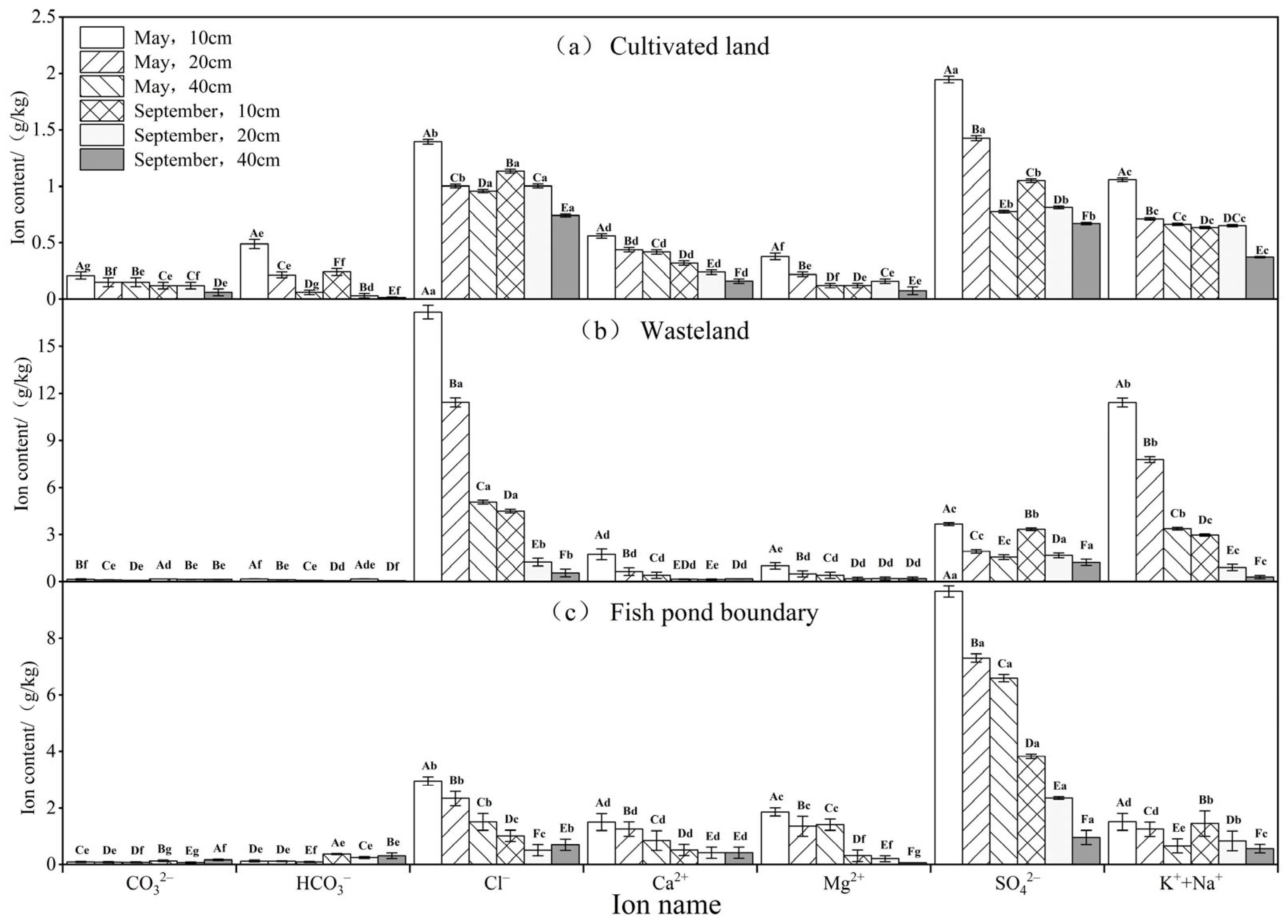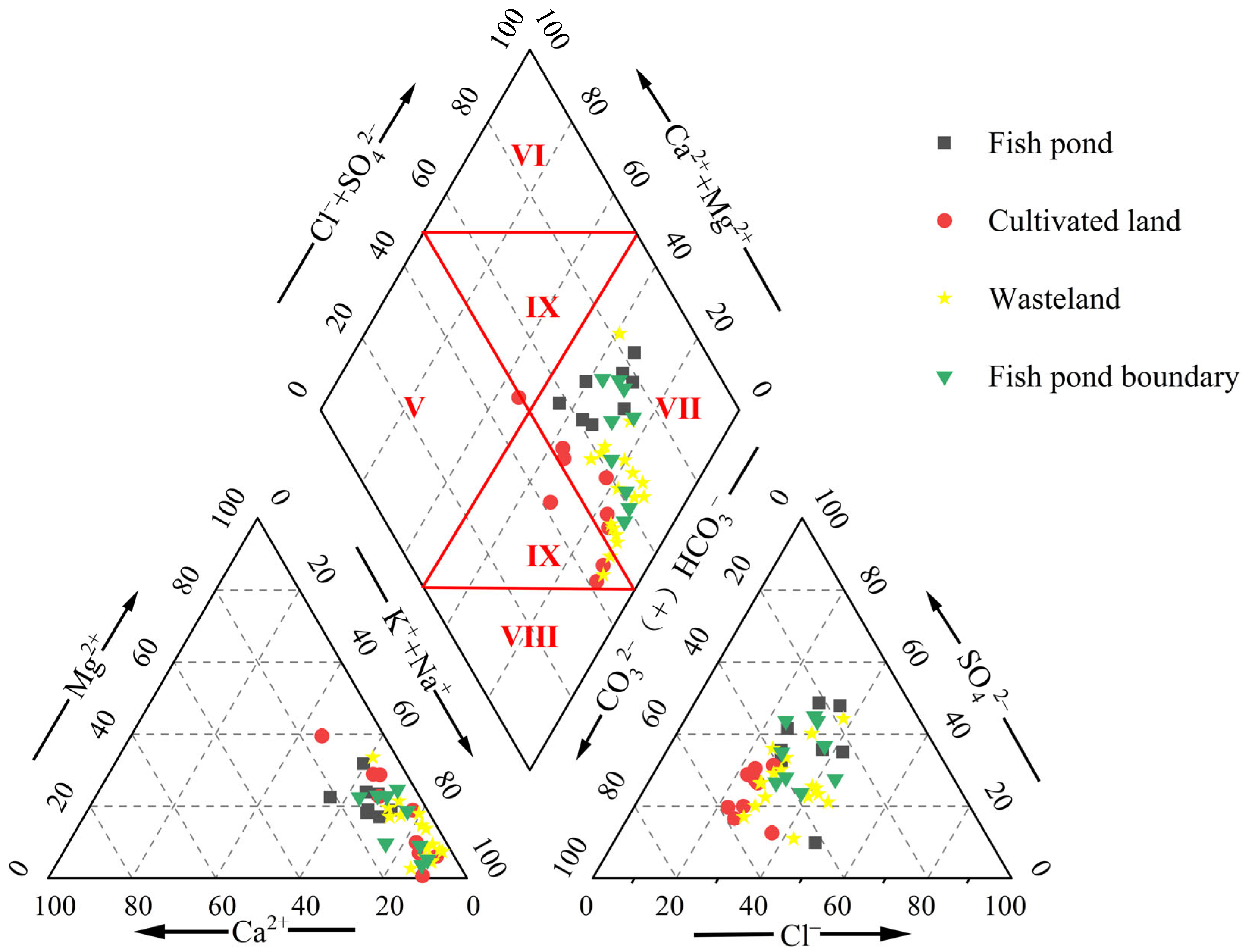Impact of Irrigation on Soil Water Balance and Salinity at the Boundaries of Cropland, Wasteland and Fishponds under a Cropland–Wasteland–Fishpond System
Abstract
:1. Introduction
2. Materials and Methods
2.1. Overview of the Study Area
2.2. Experimental Design and Data Collection
2.2.1. The Fundamental Physical Characteristics of Soil
2.2.2. Soil Salts and Salt Ions
2.2.3. Groundwater Depth
2.2.4. Water Information
2.3. Calculation and Analysis Methods
2.3.1. Soil Salinity
2.3.2. Soil Desalination Rate
2.3.3. Groundwater Mineralization
2.3.4. Soil Water Balance Analysis
3. Results
3.1. Analysis of Soil Water Balance between Cropland–Wasteland–Fishpond System
3.2. Desalination Effect of Salinized Soil in Cropland–Wasteland–Fishpond System
3.3. Characteristics of Soil Salt Ion Distribution in Cropland-Wasteland-Fishpond System
3.4. Identification of Master Ions for Soil Salt Accumulation in Cropland-Wasteland-Fishpond System
3.5. Groundwater Chemistry Types in Cropland-Wasteland-Fishpond Systems
4. Discussion
4.1. Analysis of Soil Salinity Changes
4.2. Analysis of Soil Salinity Improvement
5. Conclusions
Author Contributions
Funding
Data Availability Statement
Conflicts of Interest
References
- Shu, M.; Yu, Y.; Yin, M.; Wang, J.; Bandala, E.R.; Rodrigo-Comino, J. Super absorbent polymer (SAP) on water-salt transport in saline alkali soil: Effects of dosage, height and thickness. Eur. J. Soil Sci. 2024, 75, e13500. [Google Scholar] [CrossRef]
- Pessoa, L.G.; Freire, M.B.d.S.; Green, C.H.; Miranda, M.F.; de A Filho, J.C.; Pessoa, W.R. Assessment of soil salinity status under different land-use conditions in the semiarid region of Northeastern Brazil. Ecol. Indic. 2022, 141, 109139. [Google Scholar] [CrossRef]
- Ashraf, M.Y.; Ashraf, M.; Mahmood, K.; Akhter, J.; Hussain, F.; Arshad, M. Phytoremediation of saline soils for sustainable agricultural productivity. In Plant Adaptation and Phytoremediation; Springer: Dordrecht, The Netherlands, 2010; pp. 335–355. [Google Scholar]
- Zhao, H.; Gu, B.; Chen, D.; Tang, J.; Xu, X.; Qiao, Z.; Wang, J. Physicochemical properties and salinization characteristics of soils in coastal land reclamation areas: A case study of China-Singapore Tianjin Eco-City. Heliyon 2022, 8, e12629. [Google Scholar] [CrossRef]
- Sirpa-Poma, J.; Satgé, F.; Pillco Zolá, R.; Resongles, E.; Perez-Flores, M.; Flores Colque, M.; Molina-Carpio, J.; Ramos, O.; Bonnet, M.-P. Complementarity of Sentinel-1 and Sentinel-2 Data for Soil Salinity Monitoring to Support Sustainable Agriculture Practices in the Central Bolivian Altiplano. Sustainability 2024, 16, 6200. [Google Scholar] [CrossRef]
- Li, Z.; Liu, H.; Wang, T.; Gong, P.; Li, P.; Li, L.; Bai, Z. Deep vertical rotary tillage depths improved soil conditions and cotton yield for saline farmland in South Xinjiang. Eur. J. Agron. 2024, 156, 127166. [Google Scholar] [CrossRef]
- Chen, L.; Zhou, G.; Feng, B.; Wang, C.; Luo, Y.; Li, F.; Shen, C.; Ma, D.; Zhang, C.; Zhang, J. Saline–alkali land reclamation boosts topsoil carbon storage by preferentially accumulating plant-derived carbon. Sci. Bull. 2024; in press. [Google Scholar]
- Wang, J.; Yang, C.; Zhang, H.; Li, J. Improving soil properties by sand application in the saline-alkali area of the middle and lower reaches of the Yellow River, China. Sustainability 2023, 15, 9437. [Google Scholar] [CrossRef]
- Yang, X.; Sang, Y.; Wang, A. Study on the correlation coefficient and ecological function of eight ions and ecological factors in the fishpond of saline-alkali land. Shandong Fish. 2004, 21, 14–17. [Google Scholar]
- Li, M.; Zhang, W.; Wang, S.; Li, Y.; Zhao, Y. Suitable application of flue gas desulphurized gypsum to improve the sunflower yield in saline-alkali soil in the Hetao irrigation areas of Inner Mongolia Trans. Chin. Soc. Agric. Eng. 2022, 38, 89–95. [Google Scholar]
- Li, C.; Feng, H.; Luo, X.; Li, Y.; Wang, N.; Wu, W.; Zhang, T.; Siddique, K.H. Limited irrigation and fertilization in sand-layered soil increases nitrogen use efficiency and economic benefits under film mulched ridge-furrow irrigation in arid areas. Agric. Water Manag. 2022, 262, 107406. [Google Scholar] [CrossRef]
- Wen, Y.; Wan, H.; Shang, S.; Rahman, K.U. A monthly distributed agro-hydrological model for irrigation district in arid region with shallow groundwater table. J. Hydrol. 2022, 609, 127746. [Google Scholar] [CrossRef]
- Al-Tamimi, M.; Green, S.; Abou Dahr, W.; Al-Muaini, A.; Lyra, D.; Ammar, K.; Dawoud, M.; Kenyon, P.; Kemp, P.; Kennedy, L. Salt dynamics, leaching requirements, and leaching fractions during irrigation of a halophyte with different saline waters. Soil Res. 2023, 62, SR23173. [Google Scholar] [CrossRef]
- Ngabire, M.; Wang, T.; Xue, X.; Liao, J.; Sahbeni, G.; Huang, C.; Duan, H.; Song, X. Soil salinization mapping across different sandy land-cover types in the Shiyang River Basin: A remote sensing and multiple linear regression approach. Remote Sens. Appl. Soc. Environ. 2022, 28, 100847. [Google Scholar] [CrossRef]
- Gangwar, R.; Makádi, M.; Demeter, I.; Táncsics, A.; Cserháti, M.; Várbíró, G.; Singh, J.; Csorba, Á.; Fuchs, M.; Michéli, E. Comparing soil chemical and biological properties of salt affected soils under different land use practices in Hungary and India. Eurasian Soil Sci. 2021, 54, 1007–1018. [Google Scholar] [CrossRef]
- Ao, C.; Jiang, D.; Bailey, R.T.; Dong, J.; Zeng, W.; Huang, J. Water, Salt, and Ion Transport and Its Response to Water-Saving Irrigation in the Hetao Irrigation District Based on the SWAT-Salt Model. Agronomy 2024, 14, 953. [Google Scholar] [CrossRef]
- Yuan, H.; Yang, S.; Wang, B. Hydrochemistry characteristics of groundwater with the influence of spatial variability and water flow in Hetao Irrigation District, China. Environ. Sci. Pollut. Res. 2022, 29, 71150–71164. [Google Scholar] [CrossRef]
- Mora, J.; Herrero, J.; Weindorf, D.C. Multivariate analysis of soil salination-desalination in a semi-arid irrigated district of Spain. Geoderma 2017, 291, 1–10. [Google Scholar] [CrossRef]
- Liu, Y.; Wu, J.; Zhao, H.; Li, C.; Mao, J.; Zhang, R.; Liu, J.; Zhao, Q. Ions Transport in Seasonal Frozen Farmland Soil and Its Effect on Soil Salinization Chemical Properties. Agronomy 2023, 13, 660. [Google Scholar] [CrossRef]
- Wang, Y.; Liu, X.; Hu, X. Water and salt distribution and salt accumulation characteristics of cultivated land-barren land-sandy land in salinization irrigation area. Agric. Res. Arid Areas 2020, 38, 207–214. [Google Scholar]
- Xu, X.; Duan, X.; Dawson, R.; Liu, Y.; He, Y.; Peng, H.; Cui, C. Effects of Lucc Resulting from Tffp Land Usepattern in the Yellow River Delta, China. In Computer and Computing Technologies in Agriculture II, Volume 1: The Second IFIP International Conference on Computer and Computing Technologies in Agriculture (CCTA2008), October 18-20, 2008, Beijing, China 2; Springer: Boston, MA, USA, 2009; pp. 431–441. [Google Scholar]
- Ayyam, V.; Palanivel, S.; Chandrakasan, S.; Ayyam, V.; Palanivel, S.; Chandrakasan, S. Approaches in land degradation management for productivity enhancement. In Coastal Ecosystems of the Tropics-Adaptive Management; Springer: Singapore, 2019; pp. 463–491. [Google Scholar]
- Yu, C.; Shi, H.; Miao, Q.; Gonçalves, J.M.; Yan, Y.; Hu, Z.; Hou, C.; Zhao, Y. Water–Salt Migration Patterns among Cropland–Wasteland–Fishponds in the River-Loop Irrigation Area. Agronomy 2024, 14, 107. [Google Scholar] [CrossRef]
- Zhao, Y.; Shi, H.; Miao, Q.; Yang, S.; Hu, Z.; Hou, C.; Yu, C.; Yan, Y. Analysis of Spatial and Temporal Variability and Coupling Relationship of Soil Water and Salt in Cultivated and Wasteland at Branch Canal Scale in the Hetao Irrigation District. Agronomy 2023, 13, 2367. [Google Scholar] [CrossRef]
- Wang, G.; Shi, H.; Li, X.; Yan, J.; Miao, Q.; Li, Z.; Akae, T. A study on water and salt transport, and balance analysis in sand dune–wasteland–lake systems of Hetao Oases, upper reaches of the Yellow River Basin. Water 2020, 12, 3454. [Google Scholar] [CrossRef]
- Zhang, M.; Zhu, S.; Zeng, H.; Pang, Y. Spatial and Seasonal Geochemical Characteristics and Contamination Assessment of Groundwater in Maofeng Mountain Area. Environ. Eng. 2018, 36, 135–139. [Google Scholar] [CrossRef]
- Yu, H.; Gui, H.; Zhao, H.; Wang, M.; Li, J.; Fang, H.; Jiang, Y.; Zhang, Y. Hydrochemical characteristics and water quality evaluation of shallow groundwater in Suxian mining area, Huaibei coalfield, China. Int. J. Coal Sci. Technol. 2020, 7, 825–835. [Google Scholar] [CrossRef]
- Liu, M.; Xiao, C.; Liang, X.; Wei, H. Response of groundwater chemical characteristics to land use types and health risk assessment of nitrate in semi-arid areas: A case study of Shuangliao City, Northeast China. Ecotoxicol. Environ. Saf. 2022, 236, 113473. [Google Scholar] [CrossRef] [PubMed]
- Bandak, S.; Movahedi-Naeini, S.A.; Mehri, S.; Lotfata, A. A longitudinal analysis of soil salinity changes using remotely sensed imageries. Sci. Rep. 2024, 14, 10383. [Google Scholar] [CrossRef]
- Kulmatov, R.; Khasanov, S.; Odilov, S.; Li, F. Assessment of the space-time dynamics of soil salinity in irrigated areas under climate change: A case study in Sirdarya province, Uzbekistan. Water Air Soil Pollut. 2021, 232, 1–13. [Google Scholar] [CrossRef]
- Yang, S.; Miao, Q.; Shi, H.; Zhao, Y.; Liu, X.; Nie, X.; Feng, W.; Gonçalves, J.M.; Zhang, T.; Li, Y. Spatial and temporal heterogeneity of soil salinity and ionic coupling relationship under the water-saving renovation of a typical irrigation district in arid and semi-arid areas. Sci. Total Environ. 2024, 951, 175776. [Google Scholar] [CrossRef]
- Wang, R.; Wan, H.; Chen, S.; Xia, Y.; Bai, Q.; Peng, Z.; Shang, S. Spatial distribution pattern of soil salinization in farmland of Wulate sub-irrigation areas in Hetao Irrigation District in Inner Mongolia in spring. Trans. Chin. Soc. Agric. Eng 2021, 37, 105–113. [Google Scholar]
- Wang, Z.; Zhao, G.; Gao, M.; Chang, C. Spatial variability of soil salinity in coastal saline soil at different scales in the Yellow River Delta, China. Environ. Monit. Assess. 2017, 189, 1–12. [Google Scholar] [CrossRef]
- Wang, G.S.; Xu, B.; Tang, P.C.; Shi, H.B.; Tian, D.L.; Zhang, C.; Ren, J.; Li, Z.K. Modeling and Evaluating Soil Salt and Water Transport in a Cultivated Land-Wasteland-Lake System of Hetao, Yellow River Basin’s Upper Reaches. Sustainability 2022, 14, 14410. [Google Scholar] [CrossRef]
- Mengmeng, H.; Juanle, W.; Baomin, H. Spatial-temporal variation and attribution of salinization in the Yellow River Basin from 2015 to 2020. Int. J. Digit. Earth 2023, 16, 446–463. [Google Scholar] [CrossRef]
- Ramos, T.B.; Liu, M.; Paredes, P.; Shi, H.; Feng, Z.; Lei, H.; Pereira, L.S. Salts dynamics in maize irrigation in the Hetao plateau using static water table lysimeters and HYDRUS-1D with focus on the autumn leaching irrigation. Agric. Water Manag. 2023, 283, 108306. [Google Scholar] [CrossRef]
- Dhaouadi, L.; Besser, H.; Karbout, N.; Khaldi, R.; Haj-Amor, Z.; Maachia, S.; Ouassar, F. Environmental sensitivity and risk assessment in the Saharan Tunisian oasis agro-systems using the deepest water table source for irrigation: Water quality and land management impacts. Environ. Dev. Sustain. 2022, 24, 10695–10727. [Google Scholar] [CrossRef]
- Vibhute, S.D.; Chinchmalatpure, A.R.; TV, V.; Kumar, S.; Gorain, B.; Prasad, I.; Camus, D.D.; Shukla, M. Alternate use of fresh and saline waters to improve water productivity and soil sustainability of drip irrigated wheat in a semi-arid region. Arid Land Res. Manag. 2024, 1–20. [Google Scholar] [CrossRef]
- Fouladidorhani, M.; Shayannejad, M.; Shariatmadari, H.; Mosaddeghi, M.R.; Arthur, E. Pyrolysis of different organic feedstock combinations as soil amendments enhances the reclamation of saline-sodic soil. Soil Tillage Res. 2024, 238, 105993. [Google Scholar] [CrossRef]
- Westhoff, S.; Reese, C.; Bruggeman, S.; Moriles-Miller, L.; Perkins, L.; Joshi, D.; Marzano, S.; Clay, D. Phytoremediation and high rainfall combine to improve soil and plant health in a North America northern great plains saline sodic soil. J. Soil Water Conserv. 2022, 77, 381–388. [Google Scholar]
- Zhu, W.; Yang, J.; Yao, R.; Xie, W.; Wang, X.; Liu, Y. Soil water-salt control and yield improvement under the effect of compound control in saline soil of the Yellow River Delta, China. Agric. Water Manag. 2022, 263, 107455. [Google Scholar] [CrossRef]
- Alghamdi, S.A.; Alharby, H.F.; Abdelfattah, M.A.; Mohamed, I.A.; Hakeem, K.R.; Rady, M.M.; Shaaban, A. Spirulina platensis-inoculated humified compost boosts rhizosphere soil hydro-physico-chemical properties and Atriplex nummularia forage yield and quality in an arid saline calcareous soil. J. Soil Sci. Plant Nutr. 2023, 23, 2215–2236. [Google Scholar] [CrossRef]
- Asadi Kapourchal, S.; Homaee, M. Minimizing freshwater usage for quality improvement of saline soils in semi-arid regions. Irrig. Drain. 2022, 71, 1240–1253. [Google Scholar] [CrossRef]
- Stevenson, K.T.; Fitzsimmons, K.M.; Clay, P.A.; Alessa, L.; Kliskey, A. Integration of aquaculture and arid lands agriculture for water reuse and reduced fertilizer dependency. Exp. Agric. 2010, 46, 173–190. [Google Scholar] [CrossRef]
- Elnwishy, N.H.; Ramadhane, M.S.; Zalat, S.M. Combating desertification through fish farming. In The Future of Drylands: International Scientific Conference on Desertification and Drylands Research Tunis, Tunisia, 19–21 June 2006; Springer: Dordrecht, The Netherlands, 2008; pp. 507–518. [Google Scholar]
- Mandal, S.; Sarangi, S.; Burman, D.; Bandyopadhyay, B.; Maji, B.; Mandal, U.; Sharma, D. Land shaping models for enhancing agricultural productivity in salt affected coastal areas of West Bengal–an economic analysis. Indian J. Agric. Econ. 2013, 68, 389–401. [Google Scholar]










| Category | CO32− (g/L) | HCO3− (g/L) | Cl− (g/L) | Ca2+ (g/L) | Mg2+ (g/L) | SO42− (g/L) | K++Na+ (g/L) | TDS (g/L) |
|---|---|---|---|---|---|---|---|---|
| Cropland | 21.48 | 132.84 | 80.02 | 23.16 | 50.27 | 76.08 | 237.00 | 2.25 |
| Wasteland | 23.14 | 136.05 | 138.12 | 21.97 | 48.39 | 103.76 | 330.70 | 2.62 |
| Fishpond boundary | 14.63 | 77.94 | 86.50 | 21.26 | 40.66 | 92.40 | 209.55 | 1.95 |
| Fish pond | 10.21 | 42.95 | 62.76 | 22.55 | 40.33 | 68.14 | 121.19 | 0.84 |
| Particular Year | Irrigation Period | Flooding Quota/mm | Date of Irrigation |
|---|---|---|---|
| 2022 | Spring irrigation | 110 | 11 May |
| 2023 | Fertility irrigation | 80 | 20 June |
| 95 | 18 July | ||
| 70 | 10 August |
Disclaimer/Publisher’s Note: The statements, opinions and data contained in all publications are solely those of the individual author(s) and contributor(s) and not of MDPI and/or the editor(s). MDPI and/or the editor(s) disclaim responsibility for any injury to people or property resulting from any ideas, methods, instructions or products referred to in the content. |
© 2024 by the authors. Licensee MDPI, Basel, Switzerland. This article is an open access article distributed under the terms and conditions of the Creative Commons Attribution (CC BY) license (https://creativecommons.org/licenses/by/4.0/).
Share and Cite
Yu, C.; Shi, H.; Miao, Q.; Gonçalves, J.M.; Dou, X.; Hu, Z.; Hou, C.; Zhao, Y.; Zhang, H. Impact of Irrigation on Soil Water Balance and Salinity at the Boundaries of Cropland, Wasteland and Fishponds under a Cropland–Wasteland–Fishpond System. Agronomy 2024, 14, 2110. https://doi.org/10.3390/agronomy14092110
Yu C, Shi H, Miao Q, Gonçalves JM, Dou X, Hu Z, Hou C, Zhao Y, Zhang H. Impact of Irrigation on Soil Water Balance and Salinity at the Boundaries of Cropland, Wasteland and Fishponds under a Cropland–Wasteland–Fishpond System. Agronomy. 2024; 14(9):2110. https://doi.org/10.3390/agronomy14092110
Chicago/Turabian StyleYu, Cuicui, Haibin Shi, Qingfeng Miao, José Manuel Gonçalves, Xu Dou, Zhiyuan Hu, Cong Hou, Yi Zhao, and Hua Zhang. 2024. "Impact of Irrigation on Soil Water Balance and Salinity at the Boundaries of Cropland, Wasteland and Fishponds under a Cropland–Wasteland–Fishpond System" Agronomy 14, no. 9: 2110. https://doi.org/10.3390/agronomy14092110









